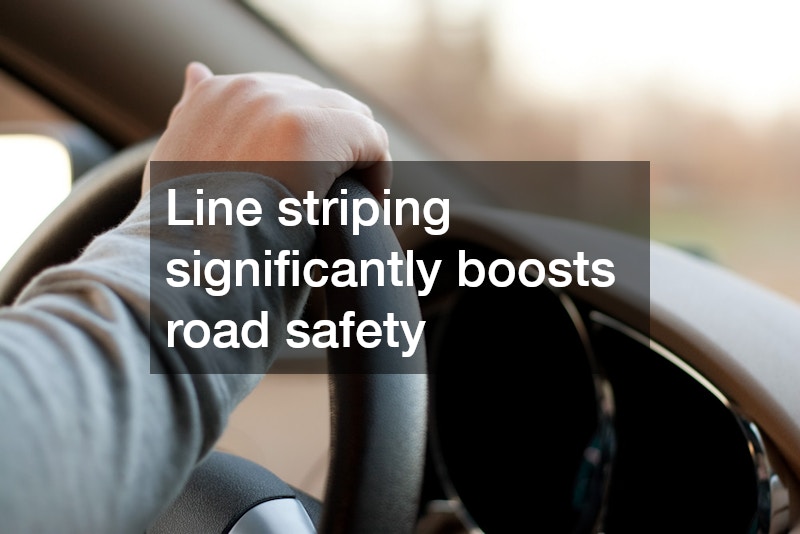Line striping is a critical component in organizing and delineating spaces across various fields. From enhancing road safety to organizing parking lots and sports fields, striping plays a pivotal role. By marking clear boundaries and guides, line striping services ensure orderly conduct and efficient space utilization.
What is Line Striping and Why is it Essential?
Line striping involves applying lines or designs on surfaces using specialized materials and techniques. The process typically employs durable paints specifically formulated for outdoor conditions.
Various methods such as spray striping or using a striping machine ensure precision and uniformity.
These lines are crucial in directing traffic flow, marking lanes, and assisting with spatial orientation. Beyond safety, they also contribute aesthetically to keeping areas neat and organized. The versatility of line striping makes it essential across diverse applications in modern infrastructure.
Effective line striping serves as an inexpensive solution to enhance functionalities in public spaces. With specific colors and patterns, line striping conveys important information at a glance. For instance, yellow may indicate caution zones, while white often depicts traffic lanes.
Line striping significantly boosts road safety by providing clear instructions and warnings to drivers. High-visibility lines are indispensable for nighttime driving and adverse weather conditions. Retro-reflective line paints enhance visibility, reflecting car headlights back to drivers.
The placement and clarity of line markings can reduce traffic accidents by guiding drivers accurately along their intended paths. Moreover, strategically placed lines effectively demarcate pedestrian crossings and bicycle lanes, safeguarding vulnerable road users. Traffic management relies heavily on the consistent and clear communication that line striping facilitates.
Without proper line striping, roads would become chaotic and dangerous, leading to frequent vehicular conflicts and congestion. Therefore, ensuring robust line striping practices is fundamental to fostering a safe and orderly environment for both motorists and pedestrians. Regular inspections and maintenance of these lines are essential to keep them effective.
How to Properly Execute Line Striping?
Proper preparation is paramount before executing line striping to ensure durability and accuracy. This involves cleaning the surface to remove dirt, debris, and any old markings. A clean surface allows the paint to adhere better, resulting in lines that last longer.
Layout planning is crucial in determining where lines will be applied, taking into account traffic patterns and usage requirements. Detailed planning helps avoid wastage of materials and ensures that all markings meet regulatory standards. Using temporary markings or chalk lines can assist in outlining the intended design before the final application.
Establishing a comprehensive plan beforehand facilitates smooth execution and minimizes errors. Factors such as environmental conditions and surface type should be considered during the planning phase. Planning ensures that the line striping project achieves its functional and aesthetic goals efficiently.
Selecting the appropriate materials and equipment is crucial to the success of a line striping project. Different surfaces and conditions may require specific types of paint, such as water-based or thermoplastic. Durability and visibility are key factors in choosing the right striping materials.
Striping machines vary in complexity, from simple manual sprayers to advanced ride-on models equipped with guided systems. The chosen equipment should match the project scale and precision requirements. Investing in quality materials and equipment ensures the longevity and effectiveness of the striping.
Inadequate materials can lead to premature wear and faded lines, necessitating frequent re-striping. Ensuring compatibility between the equipment used and the materials applied is essential to prevent failures. The initial investment in suitable materials and proper equipment pays off in long-term durability and maintenance savings.
How to Maintain and Repair Line Striping?
Regular maintenance is essential to preserve the functionality and appearance of line striping. Routine inspections help identify any fading or damage that might affect visibility. Addressing these issues promptly ensures that lines remain effective and compliant with safety standards.
Conducting periodic cleaning of the marked areas can prevent buildup that obscures visibility. Pressure washing is an efficient method to maintain clean and visible lines. Scheduling routine touch-ups based on wear and traffic intensity ensures markings remain legible over time.
Preventive maintenance reduces the likelihood of more extensive repairs or re-striping, saving costs in the long run. A proactive approach in maintenance not only enhances safety but also reflects positively on the facility’s overall management. Consistent upkeep extends the life of line striping significantly.
Unfortunately, line striping can succumb to various forms of damage, including fading, chipping, and abrasion. Heavy traffic and environmental exposure are common culprits that contribute to line wear. Addressing minor damage swiftly can prevent it from escalating into more significant issues.
Quick fixes may include repainting the affected areas or applying protective sealants to bolster resistance. Ensuring that lines’ visibility remains unimpeded should be a maintenance priority. Temporary touch-up solutions can buy time until more comprehensive repairs can be implemented.
Predictive maintenance strategies can help anticipate the need for re-striping, minimizing disruptions. By re-striping during low-traffic periods or scheduled maintenance windows, facilities can optimize productivity while ensuring safety. Attention to timing and thorough assessment makes the re-striping process both efficient and effective.
The importance of proper line striping techniques and maintenance cannot be overstated in ensuring safety and efficiency. From enhancing road safety to facilitating organization in various industries, line striping is an indispensable tool. By adhering to best practices for application and maintenance, facilities can achieve durable and effective markings.

